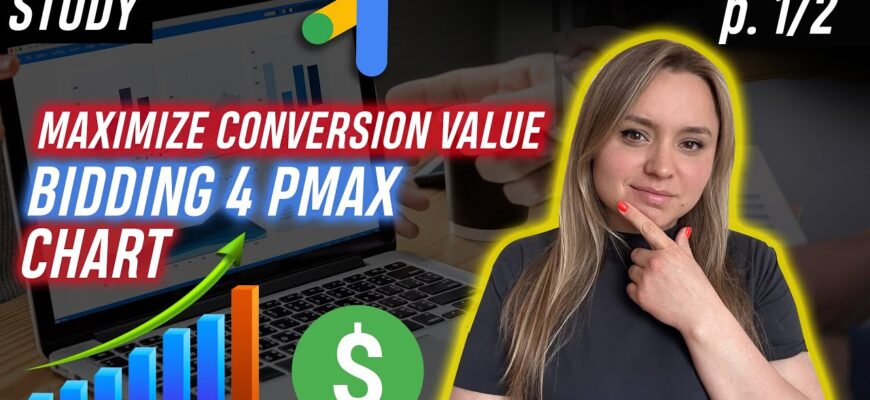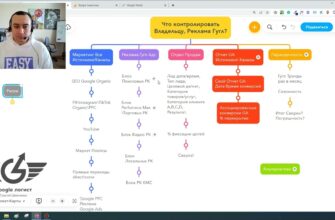- Why do questions arise when moving between maximum conversions and profitability?
- The difference between maximum conversions and profitability
- Maximize conversions
- Target profitability
- The “golden mean” of payback and sales
- Changing profitability targets
- Why is there a drop in sales when you move from maximum conversions to profitability?
- How can I avoid dips when switching to profitability?
- Features of the results of using profitability
- Why shouldn’t you leave the settings static?
- What happens when you switch from profitability to maximum conversions?
- Experience in using the use of profitability
- Choosing a strategy. Moving through the quadrants
- Initial data are organized into quadrants
- Analysis of mapped data by quadrant
- Analyzing products by price tag
- Consideration of the first segment (less than/equal to $1500)
- Consideration of the second segment ($1500-3500)
- The third segment ($3500-7000)
- The fourth price range ($7000-15000)
- Fifth segment (more than/equal to $15,000)
- Moving from the first quadrant to the neighboring ones – up or to the right
- What is the point of this video?
- How do strategies work when starting with small budgets?
- The influence of the average check size on the achievement of results
- What is the best way to switch to profitability and what kind of profitability should you set?
- How to conduct a profitability test?
- The difference in the strategies of target profitability and maximum conversions
- Tips for this advertiser
- Analysis of the changes made by the client in campaigns
- Conclusions on the project analysis
Hello, everyone. My name is Yana Lyashenko and I’m a Google Logistician. I am engaged in delivering the target audience to the business with the necessary parameters, helping to scale your online sales with the help of smart intelligent strategies in Google advertising campaigns using AI tools. And in today’s video, I think I’m going to shoot it for those people who are more interested in understanding the nuances of the difference between these smart intelligent strategies in a single campaign, which is now the most advanced advertising tool that Google can offer us, which is Performance Max. This answer, it will be based mostly on the questions that were asked either by specialists in consultations or by businesses that like to adjust something on their own, to find out the dependencies. That is, people who like to detail and understand all aspects of what is happening here.
Why do questions arise when moving between maximum conversions and profitability?
Why is this question asked so often? Why, after switching from maximum conversions to profitability, do my sales drop, or vice versa, or even situations when profitability drops so much that I switch to maximum conversions and the result completely disappears? Now we will consider the difference between them, what are the nuances. Look, everything I’m going to say is based on my own observations, my own experience. Your experience may be different. You can share it in the comments directly so that people can also get acquainted with an alternative point of view. I’m going to draw it, tell it based on what I saw. These are my own observations, my individual ones.
So why can’t this be 100% true? Because I don’t write this advertising tool. I don’t know how it’s embedded, what algorithms are used. Plus, there is an AI machine sitting there. As you know, if you constantly give it the opportunity to learn, it can do even completely different things that the developers who built the algorithms into it may not even realize.
How many calls and sales will I get by ordering contextual advertising from you?
I need to calculate the conversion of my website Describe
the task
in the application
Calculate potential ad revenue Google
contextual advertising calculator
The difference between maximum conversions and profitability
So today we’re going to figure out what the difference is, why there are always few sales at the maximum conversion rate, and more at the profitability rate. How to make more out of profitability, perhaps more out of sales, without losing profitability and payback rates. In which situations, perhaps, you will get the most conversions. Let’s deal with all of this. Why will I focus only on these strategies? Because we will be looking at Performance Max. It has only two strategy options.
Maximize conversions
So I’ll start with the maximum conversions. Let’s imagine that this Y-axis is our revenue in dollars, and I’ve signed it here. And the X-axis is our quantity. And this black line, the one that goes through the entire graph, is what all businesses strive for, to grow very quickly and systematically in revenue, in units, and so on. I also have this graph… Sorry for the closed lines, they won’t be elegant enough, beautiful enough. I use a free, free drawing program. It’s easier for me. But I think it won’t break anything, if there is a person here who wants to write it more beautifully, write to me in the comments. We’ll visualize it visually and make it into a nice PDF.

Look – there is this straight line, which is what we are striving for – to increase the number of units, while increasing the payback. I also divided this graph into four quadrants. Why four quadrants? If we follow this logic, what can we have here? That’s right, here we can have a certain number of sales. Yes, I’m marking it with a dollar to define the volume and some quantity. That’s right, a piece. Because if we draw a point somewhere over here, for example, we put a point over here or a point over here. We can see that we haven’t really moved anywhere. Right? We don’t have enough of both. Right? Maybe we are even on this line. This is how maximum conversions work.
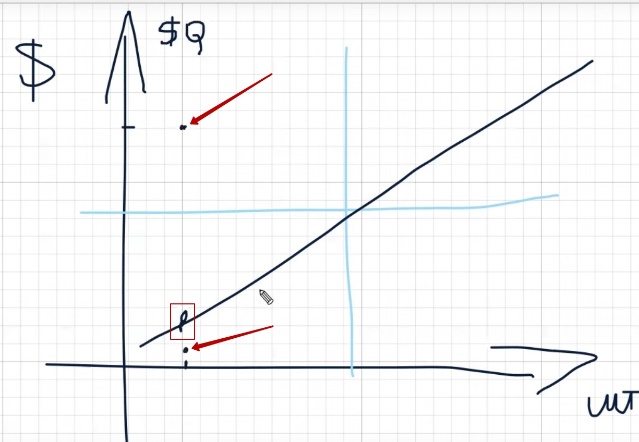
How does it differ from profitability? Because it tries to follow proven paths only. And proven paths for most, for example, online businesses are either how previous conversions were achieved. Therefore, it is important what kind of conversions you put into this ad account, what types of conversions. Why calls or not calls should not be added, in what situations – this is another story, so that you don’t add something left.
Why should it be conversions? But it’s okay, I won’t confuse you. Either it’s how these conversions were achieved, or if we’re focused on buying for online stores. This is a stupid primitive model on which this machine learning is built. This is viewing the product card, adding it to the cart, and buying. And this maximum conversion rate is usually only valid within this line. Right? Here it is within this line. I will draw such short dots.
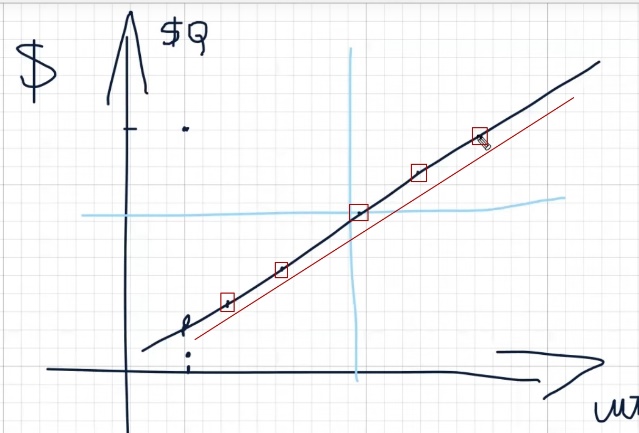
It can go beyond this graph, but not too far away. So, most likely, even our point will be there, even if it’s not here. Right? Not even here. Our point will be somewhere in this quadrant. Although, for example, there may be one random sale. But we still haven’t achieved anything special.
Money, money, let’s go, there seems to be a lot of it. Let’s draw two dollars. That’s right, we are high in this block, but we have not sold enough quantity. In this quadrant, we have both low money and low sales units, dollars and quantity, directly. If we look here, we have everything. We have dollars here, too, right? It’s going to be ugly. I’ll mark them as $3, showing that it’s kind of expensive. The stuff here is going to be awesome, right? I mean, here we have everything to the maximum that we can achieve. If this sale suddenly happens in this quadrant, of course, there won’t be many dollars. But here there can be a lot of pieces.
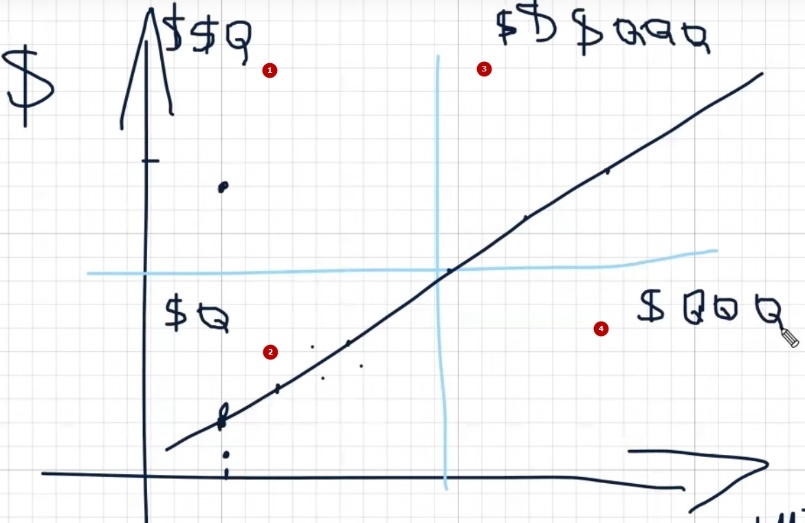
The difference between maximum conversions and profitability is how it moves along this graph. Of course, depending on your check, this is very important. It’s not possible for the maximum conversion rate to be too high… Let’s take the example of purchase/order conversions, sometimes above a certain check in different niches. It can be a different check. For swimming pools, it can be one price, much higher. For some kind of kitchenware theme, for example, it can be up to how much, up to 1,500, up to 2,000. It can be, for example, up to 50 euros. It can still work effectively, but it can’t go any further.
That is, if you can think of it that way. Let’s take the color purple for this conversion. Depending on your niche, depending on the check that you launch, depending on how you started this strategy, not its… This strategy maximizes conversions, it is very sensitive to budget ratios, cost per conversion. That is, it is an ideal strategy for launching, for starting. For scaling, it is often very difficult. For example, if you find a case study of a household product on YouTube. Something like that. And where there were many, up to 200, 300 sales per day, we had to do it. By the way, there was a separate test for conversion/profitability. In terms of profitability, it’s a cannon, it takes off. In terms of conversions, it is very slow. But it gives a certain cost per conversion. But this is a completely different topic.
For example, if we launch our Maximum Conversions program with a certain niche and a certain price. And we have a lot of niches. This is a separate story in auto parts. Selling flowers is another story. I don’t know, coffee, tables, furniture, cabinets, whatever you want. Mopeds, and it went from there. These are different niches, there are different rates for this, limits. It will usually be the average for a hospital. I’m not saying that this is your situation, but in most cases. If you look at my Telegram chat, for example, people often write the following messages in this personal chat: “I’ve launched at maximum conversions, my conversions are great, I’m growing there, but my price is quite low.” That’s how he does it, it works out quite well. There is a check, let’s say up to 500 UAH.
If we take this case, the maximum conversion rate, how does it work? It’s like this, conditionally. Let me take the ellipses. Have you ever seen a dot plot? You know, when there are a lot of dots. Right? Here are many of their points. I’m going to draw them ugly, but you’ll understand. Here they are somewhere, here they are somewhere. That’s right, here, here, here. Maybe here and there, depending on what price you have launched there. Yes, but there will be much fewer of them, and it will try to move, depending on how you manage the budget, whether you manage to increase it, the amount of increase in this budget – it will all move along this dot chart. These points are sales volumes, new customers, and so on.
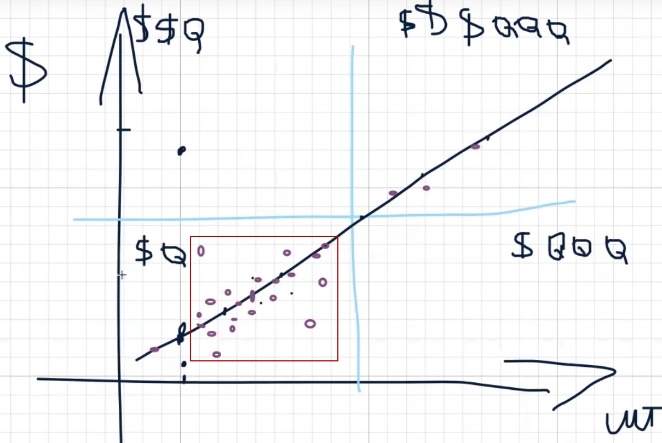
In general, they often write checks for up to UAH 500, how many euros is that? Up to 15 to 20 euros, somewhere around that, even if it’s dollars, depending on the exchange rate in Ukraine. It will try to cook in this part of the market. This part will be hers, directly, where she will drive out these sales. Yes, there will be more sales somewhere over here. Maybe even somewhere around here. They will be here and they will be here. Because you can’t say that the automation and AI that works, it works only along this line.

It will work, for example, in search, or it will work in the KMS, and this story will gain conversion exactly along this line. After all, it is AI. It knows how to use audience targeting and go beyond. But still, these volumes are beyond the scope of this case, for example, the case we are considering, home goods, kitchen and bathroom stuff, whether it’s a tool or a kitchen utensil. But they have a check, for example, up to 20 to 30 dollars maximum. I’m guessing that, depending on the niche, it may be more expensive, and there will be conversions, and we’re only looking at purchases. It’s going to be brewing somewhere else. Yes, it will jump into different segments, but these sales volumes will be smaller.
Target profitability
What is the difference with profitability? This profitability depends on the size of the budget, and more factors come into play here: the size of the budget, your old analytics, what products you bought, the price of the product item, and your planned profitability. That is, the profitability value that you set in the settings, I will call it the plan. It’s a combo of all these factors. That is, it doesn’t care whether you left only 500 UAH worth of goods or added 50,000 UAH. It will also use it to analyze and model some behavior in advertising, attitude to your price.
That is, she will notice it all very dramatically. That’s why it’s not recommended to set a static value for a purchase, whether it’s 300 UAH or 10 bucks. It is recommended to make it dynamic, so that the system can see what result it brings, what discount you have made. Why, for example, the product cost 30 bucks, but the revenue was only 15. It analyzes all this. So, this guy is already profitable. For example, we are considering a maximum price strategy. This fellow… Let’s say he’s adding up all the purple circles we’ve drawn. There will be much more of these dots here. There will be many times more. There will be many times more. It hits where you need it to. It is very high. You see, I’ve already drawn it. At the same time, this fellow can capture very large parts of different graphs. It depends on your… You can see that this is a very advanced AI that can enter different aspects of this quadrant if it has something to learn.
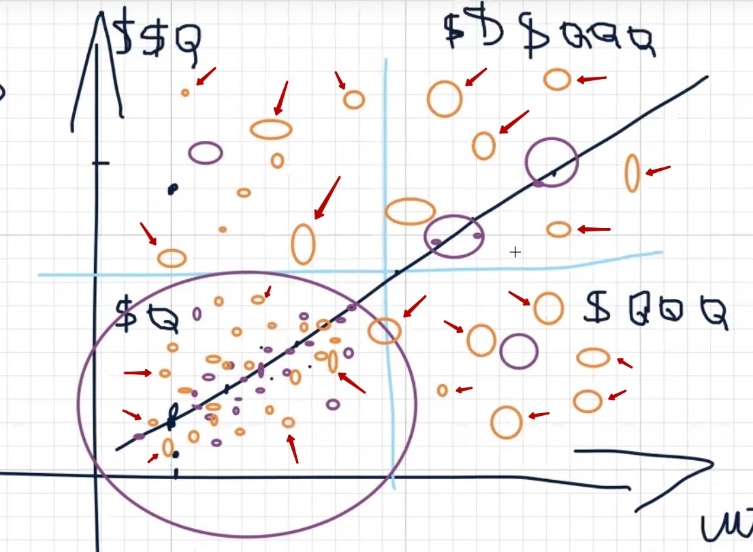
If it has a base to learn from, it understands what is happening with goods. That’s why, for example, there are a lot of people trying to hack the system with additional feeds or something like that. So it may not work. Or, for example, it works very poorly somewhere. In the performance, it’s very good. It looks like this. And it can get in here and here. And cook here. It can go into different quadrants. This is the difference. The ability of the system to squeeze out a certain payback. In other words, there will be a golden mean here.
The “golden mean” of payback and sales
Let’s imagine that there is a golden mean in the middle, where you get a great return on investment and a lot of sales. You feel free, you are satisfied with the advertising. Yes, you would like to have more marginal products or just more stuff, but so far, everything is great. And the way you manage your advertising, it sags a little bit in profitability right away if you try to increase things. Or it comes in somewhere, but now it’s a happy medium.

This is the golden mean, on this basis, this golden mean, the system can learn if you teach it. You give it an instruction. It can move very well in any of these quadrants, depending on what you need.
Changing profitability targets
In addition, this golden mean, where you will move next, is greatly influenced by your settings of the planned profitability values. Therefore, you need to constantly play with profitability. You have to play with it all the time. Why? Because Google’s task is to bring your plan, what you set in the settings, to… Let’s put it this way, the fact that we will receive, so that it completely coincides with the plan. This is built into any AI software so that it is like that. You set a certain percentage of profitability. Is that right? So he will try to bring it to a certain value in these percentages.
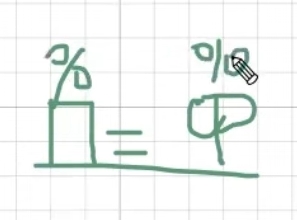
Plus, if you’ve noticed, if you’ve had Performance for more than a month, Google asks you to lower this target value all the time, because most of us set it too high. I mean, in the system, it’s interested in making money as well as giving you benefits in proportion, right? And it is constantly trying to lower your bar. The plan is even less, even less, even less, so that the fact is proportionally reduced.
You need to understand this. This is another reason why you should always try to play with this plan, so that you don’t let Google control you, but try to manage it, get into different structures, something like that. If I can exaggerate it, it’s a very simple way to describe it. Maybe it’s not pretty there, it’s not pretty, but it’s conventional.
Why is there a drop in sales when you move from maximum conversions to profitability?
Why, then, when you move from maximum conversions to profitability, do you experience a significant drop in sales? I mean, basically, you were, for example, somewhere at this point, at this point everything was great. Everything was fine and you switched to profitability for various reasons. Someone on YouTube, like me, for example, said profitability is cooler, some specialist came somewhere and did it. Or, for example, Google recommended you to do it, and you’re doing it like this, for example. Right? Why is this happening?

The problem is only in the figure of the plan that you have set, which is the key. Because before, where Smart shopping used to work, we had a scheme for calculating marginal profitability. We had a Break Even ROAS. I’ll call it Break ROAS. We calculated it based on the margin we are willing to spend. Now, we will use this Break Even ROAS only to assess whether Performance is working OK or not. But not to directly set our target value, the value of conversions. So that you can understand it. So that the letter P is clearly visible. This is the picture.

Why did these changes occur? Because, well, first of all, Google is improving its targeting mechanisms. Plus, there are more advertising tools. Plus, there is AI, a bunch of stuff. Maybe there are negative factors. Yes, there is more money to be made on the part of Google, because it is still a corporation. Imagine Google is a big corporation. It’s like a big state, where there are different situations, if you know what I mean. So it’s not us who manage this monopolist, right? It manages the whole auction. We just have to adapt. That’s probably the main topic of this video, how to adapt to all this, or why you can’t adapt.
So, when you set the profitability, you fall for only one reason, you fall because you set a very high profitability. You have set it towards the Break Even ROAS plan, most likely, or Google has recommended you a very high one, and everything just falls apart. That is, not even conversions, but somewhere shorter than here, they are moving, you are rolling back very much. For some, it’s just that their impressions have dropped and so on.
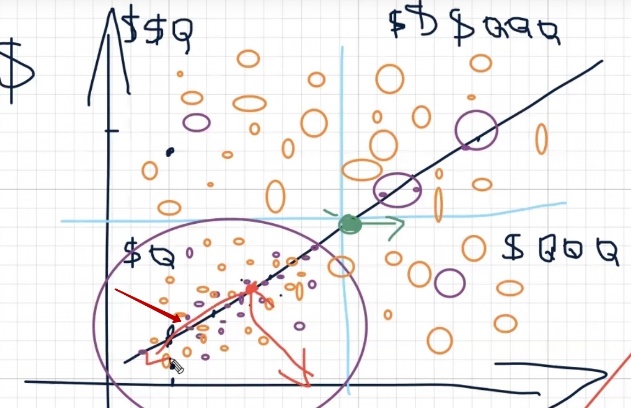
How can I avoid dips when switching to profitability?
To avoid this, you need to not set the profitability, first of all, which is specified in the recommendations. Secondly, based on your Break Even ROAS, if you are satisfied with the result. And you don’t need to set the actual one that you got. Because in this way, you will put your ad account on a substantial ass. That is, it will sit down, it will roll back to this point somewhere and will only sit here. This is a negative situation.
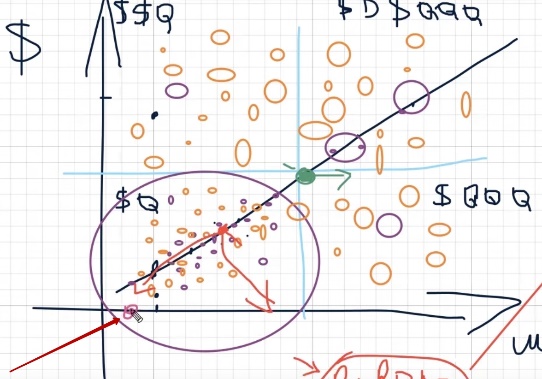
When you move from the maximum conversion rate, you need to correctly define the profitability that you will go for. There are certain figures there, I won’t name them. You need to choose these values depending on the niche of the projects you want to start. You can come for a consultation, and we can talk about it all. Because if I say a number, someone will come, someone will go, someone will listen incorrectly, again, not listen to everything, rewind, make a mistake, write me a negative comment. If you want, you can come to me and we’ll work out how to function and work without any problems.
The only thing we need is for it to be smaller. The plan should be much smaller, not equal to, but much smaller than the fact that we want to achieve, which you received, for example, at the maximum conversion rate. You need to choose how much it should be. Plus, you need to set an additional budget, and then, most likely, yours will be the maximum conversion rate at the point where it will move towards the golden mean. Where is it here? It will move towards the golden point, towards this green point of ours. And maybe even higher.

You need to understand that you need to sell a check at a higher price. Here, the price is higher because the units, the income, they can be the same. Here, most likely, if the price is the same, you will be somewhere in this quadrant. You shouldn’t go to this one, because the price is much higher. Here you have to try hard to get in. This is also not bad, but there are few sales here. Quantity is not enough here.
This whole graph is applied to any volume of your sales. Whether there are a lot of circles here, like I have, or there are only 10, I don’t know, per month, or five of them in total, it doesn’t correlate at all, everything is subject to this quadrant. Getting into the top ten of your Performance Score depends on how well it can understand who to target, how likely it is to hit the orange dot, for example, which pays off for you completely, or whether it will hit, for example, the red dots, which may not be completely profitable for you for various reasons. It has earned money, but at the same time, the spread of your expenses can be very significant, and it essentially follows this schedule. But no, it doesn’t fit the spread. That is, Google has killed the cost per click there, or the conversion costs of your site are too low, and so on. These are the nuances.
Features of the results of using profitability
This is the difference why, when you switch from maximum conversions to profitability, everything drops. Because it should be the other way around – profitability is much more flexible. There is no longer this linear graph that goes through it. It moves along it, but it’s a kind of wave. Its height, the width of this wave, which will pass through this block… I’ll put it in gray.

It depends on how stable your account is in generating these conversions, how clear the client’s avatar is, how much the market is covered, right? If we try to target Romania, where Google says there are 12 million people, or Germany, for example, or the United States, where there are 300 million people, or whatever, there are millions of people. This is a completely different picture, the size of this wave. It fluctuates up or down, the size of this wave depends directly on what kind of stuffing you put in your account.
Any automation or maximum conversions, or profitability, it will be based on your account-level analytics. Any new campaign, even in an old account where there are sales, everything is fine, it will first turn to all the account analytics, conversion analytics, when you start. It is logical, right? Why not use it instead of generating it all in a new way? Like, for example, KMS. You can launch a new KMS and it goes in a completely different direction. It doesn’t work at all, even though the targeting is the same, and it’s going in the same direction. It can’t do anything. Here, AI can learn, expand this wave, shrink this wave, somehow make it oscillate. Is that right? That is, at an angle, at an angle. AI can do all this.
That’s why when googlers offer you their best practices based on their best cases, let’s break 3,000 pounds, remove the profitability, and everything will be great. Or, for example, they tell us to maximize conversions before launching… I don’t know why they say that. Some googlers say that you need to have 50 conversions in your account first, only then will the maximum conversions work. Others say that only profitability with 50 conversions will work. It doesn’t matter how many conversions you have, you can start with maximum conversions, but if you want to scale, to move forward, you will have to switch to profitability. Even Google itself will ask you in its recommendations. Not all recommendations are useless. He just makes them on average.
Look, he will take a sample of, I don’t know, let’s take a sample of Power Sockets, for example. Let’s say it’s Prom, let’s say it’s Allo or something. And, for example, 10 small shops that clearly do not have the budgets of a Rosette. And it will simply display recommendations based on the average. That is, it will not remove the maximum, for example, the minimum outlet of some very small store and display the correct average. No, it will take all of them and derive the right average based on them. What is suitable for Rozetka is not always suitable, even for the same Prom or for a smaller store. That’s why not all the recommendations that Google makes are not useful, they are all useful. You just need to understand whether they are appropriate in this case or not. Well, that is, only to this point. But I’m telling you that even Google will offer to switch. Because it’s more voluminous, it’s more ambitious, it’s more flexible. It can go into different quadrants, and you may be very satisfied with the result, or you may not be satisfied at all. It’s up to you personally how you will manage this advertising tool.
Why shouldn’t you leave the settings static?
Leave it just in a static form? I don’t know, it’s not for everyone, it’s just launched once and you don’t touch it anymore and it works. There are very few niches like that, most likely, if you want to move up the quadrant, right? You have to do something to grow. If you want to achieve a goal, you have to run towards it. If you can’t run, walk. If you can’t walk, lie down in this direction. It’s the same principle here, without doing certain things in your account, you can’t achieve more. That is, whether to move here, for example, if you are still limited by something, or to move to this quadrant – it all depends on whether you want to or not, and whether you will take some actions in your account or not. In general, it looks like this.
What happens when you switch from profitability to maximum conversions?
What happens when you take off from profitability to maximum conversions? It’s pretty much the same story. It is very much narrowed down. But the advantage of maximizing conversions is what? If he can immediately use analytics or your feed analysis when we start from scratch… It does not necessarily need conversions. If he needs to find cheap conversions, he will find them. Now for maximum conversions from a budget, he can find what he can, especially on starting budgets of 8-12 dollars very easily he finds. But if he can’t find, for example, or there’s very little traffic you’re getting, then your option is only profitability, strategy, maximum value, either with or without a limit.
Experience in using the use of profitability
Most large projects work on profit margins. It gives a higher yield. It provides more impressions, more traffic. As a result, more clicks. And the googlers who draw or give you recommendations are all supported by numbers, they are all real, but in most cases they are, for example, our overseas cases. They are American or European, or based on a particular country. And most likely it will be a very large advertiser. Most likely, they will be able to spend 3000 pounds or 3000 dollars in a week. For the majority of small and medium-sized businesses in Ukraine, they can spend that amount, but they would like a proportional result.
This is especially true for small or start-up stores. You don’t need to make sprints right away, it won’t pay off. You just gave Google money because it is not clear whether you will collect the right analytics or the wrong analytics. You will move along these quadrants somewhere or you will not move along these quadrants. Perhaps you will be somewhere in this block, which is pointless. 3000 dollars per week will not pay off in any way at all.
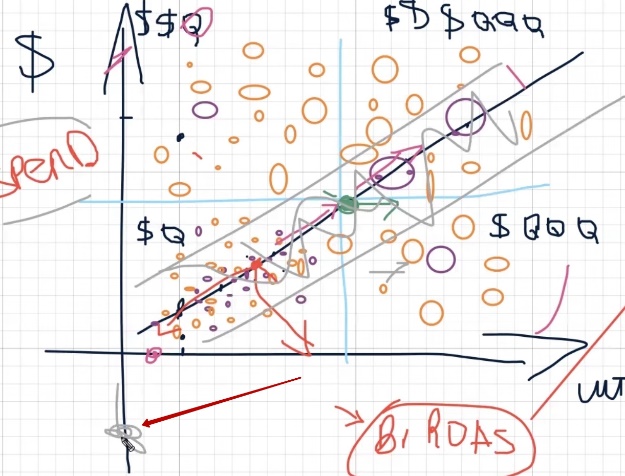
All these best practices are based on the average. In Ukraine, I haven’t seen them appealing to Ukrainian cases yet. Either there are very few of them or they don’t publish them much. But, for example, American or something else, you need to understand that their spread is higher, they collect analytics faster, so their performance is more variable, they can rely on some indicators.
Choosing a strategy. Moving through the quadrants
But this does not mean that you have to apply the same model in full. Your task is to understand where you are moving, what quadrants you want to go through, and at the right moments to switch to a certain strategy, or change this strategy, or remove the profitability, or set the profitability. At some point, you want to switch to the maximum conversion rate for some products or vice versa. In general, I don’t see anything critical in both strategies. If you want to scale, there is a margin of safety in terms of margin, because if you have unprofitable advertising at the maximum conversion rates, then this will most likely be proportionally increased by profitability. Most likely, you will grow in these things, but you will not grow in revenue.
The same goes for profitability, when you’re pumped up, you seem to have high profitability, but you want to increase the same things here – quantity. Here you want to jump from this quadrant to this one. Or from this quadrant to this one. Or from this quadrant to this one, it doesn’t seem to depend on it.
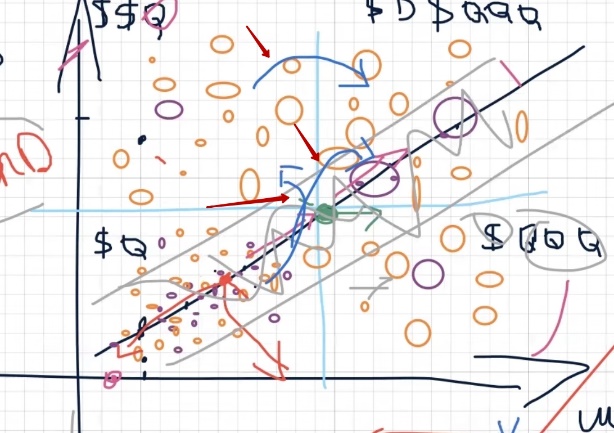
This is all possible if you try to make adjustments based on the fact that you have achieved and the Break Even ROAS. How different they are from each other, how different they are at all. If advertising is no longer paying off for you there, then it will be very difficult to jump into any of these quadrants with the help of profitability.
That is, you need to first bring advertising to this middle of the green golden mean, or whatever you want to call it. And then from there, it’s very quick and easy to dance to any quadrant you need. Moreover, these quadrants can be applied even to any price ranges, categories, intersection of products, and so on. All of this is applicable to different situations on the account and can be scaled down or up according to the fractal principle. It’s the same principle: to jump up or down a quadrant, you need to know how to edit a picture or a situation.
For example, if we made a few, small number of sales there. They are profitable for us. In order to increase them both in terms of revenue and units, we need to lower our requirements for Google in terms of targeting. Because our ROAS is most likely very high here, it’s very high, and we need to reduce it by a certain percentage, and then it will be easier to jump over here. But if you go too far with this reduction, you will very easily jump, for example, here. You will remain at the same number, but your income will drop very sharply. Or you can move here, but in no case to the fourth or second quadrant, or whatever you want to call it, depending on how you count here.

If we want to jump from this quadrant to this one, then most likely the problem is only in your budgeting. That is, it will be very easy to solve here. The profitability of this can be left untouched. But if we want to jump from this quadrant to this one, it will not be quick. Because it’s very difficult to jump diagonally like that. You either have to sacrifice a certain amount. That is, first jump over here, sacrifice income, and then move up to the top quadrant on the big stuff. Or you can do it the other way around, first increase profitability on small items and then jump here.

Initial data are organized into quadrants
I painted the same quadrant here. Today it’s a bit flatter. Here are some things. I took a hundred numbers here, approximately. Because the maximum number here, I think, is 73 conversions, and there are no more. I took at least 15 conversions, which means that nothing will likely come out of this line at all. And I took our profitability at 50, because we have a maximum of 37.5, and I thought if I took a hundred here, it would not be correct enough. So the profitability here is great, and now we’re going to draw a fairly primitive graph. The point will be to find these points.
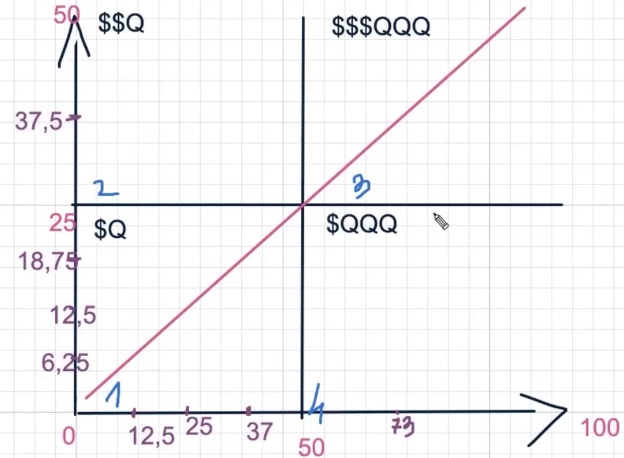
That is, the first point is 73, 36. And let’s take, for example, let’s say it’s the same 73. And let’s say it’s 36.

Approximately… I’m going to take another color, this one will be orange. 73, 36. Let’s say it’s somewhere around here, let’s probably draw some nice ellipses like this.
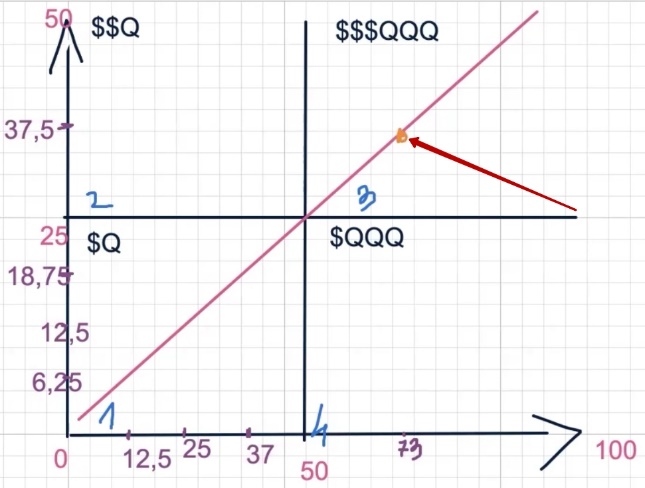
Then we have 46, 14 goes on. Again, we just take a blank page and draw. I think 46 will be somewhere around here. І 13. Well, it could be somewhere around here, right? 46, 13. 14, to be exact, right? 46, 14. 46, 14. 46, 14. This is 37, this 46 will be somewhere here. We’ll erase this one now.
Okay, let’s move on, let’s see. 39, let’s say 40, 24, right? 40, 24. 40 should be somewhere around here, right? 40. How many 40s do we have there, 24. We take 40 and there will be 24 here somewhere. Let’s sketch it out so that we don’t slow down too much, let’s put it here. Then 37, 15. This is probably what I’m going to sketch. 37, 15, right? Somewhere around here it could be 37, 15. 33, 21. Let’s put 33 somewhere here. 21 should be over here, right? 29, 16. Well, let’s say it’s 29, and here it’s somewhere around 16.
Very schematic, very primitive. You can make yourself a beautiful graph. I tried to do it for the video, to imitate such an activity. 28, 17. 28 is fine, there’s a 17 here somewhere. Then we go 27, 17. 27 again, here there will be about 17. They will be stuck together here. 24, 25. 24 somewhere, 25. 19, 14. 19, let there be 19 somewhere here. And let’s put 14 here.
I took specifically conversions over 15. You can take all the campaigns. I’ve done it, we can look at the smaller ones if you want. We’re done with 19, right? What do we have here? 13, є 8. Let’s do it like this: 13, 8. Let’s say 13, there will be eight here somewhere, right? To make it more like this. 13, 8. 10, 27. Let’s say it’s 10, and here is about 27. As you can see, there are fewer and fewer things that go beyond this bar. 8, 6. Let’s say it’s 8, 6, maybe even lower. 8, 6. We’re coming here again. 8, 12. 8 will be somewhere, 12. Let’s take this big one and that’s it. Let’s make it 7 and 32. Let there be 7 here and 32 there.

Analysis of mapped data by quadrant
What can we see from this? If you watched the previous video, we can see how our strategy works, or rather, the “Maximum Conversions” strategy. Here, most of the advertising campaigns are for maximum conversions. There are some for profitability. However, due to the small budgets in this account, in fact, the small advertising budgets of these campaigns and the small volumes of conversions, this is the picture we get. That is, most of the maximum conversions are cooked in this quadrant, as I described. Everything is cooked here, digested, and everything else.
How many calls and sales will I get by ordering contextual advertising from you?
I need to calculate the conversion of my website Describe
the task
in the application
Calculate potential ad revenue Google
contextual advertising calculator

If you want to scale all this, you should at least try to move here. You can, of course, try to raise profitability and so on first, but I will now show you why the client will not be able to do it just like that and why you need to first go for a few things here and then try to move from this quadrant either here or right here, although it will probably be quite expensive for him to move to the third quadrant, because there are still certain aspects here. Yes, look here, the profitability is all great. They are all above the adequate standards that most customers need. If they are 37 and so on, but the question here is most likely that some conversions are not calculated correctly, because I saw 13 purchases from two clicks, something like that.
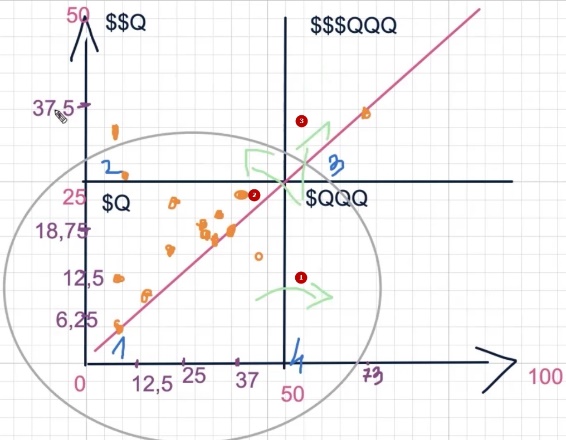
Most likely, this analytics will be blurred, so we are looking at this purely technically, understand that these are just the numbers you want to achieve and we are just analyzing. The first stage is to try to scale up here, because all campaigns are cooked in this segment.
Analyzing products by price tag
At the same time, I conducted a very interesting analysis for myself. I roughly estimated which products are marketable here. I divided them into five segments. They can be reduced by more or less. Depending on the number of products in total, they have about 16,000 active products ready for display. This is what is in orange – these are the items that were made with conversions of more than zero. That is, I took into account what is in orange, all these values, the analysis.
If you know a data-driven attribution model, it can count hundredths of a conversion, these half conversions. Hundredths, tenths, and so on. They are called longtails, which will take a long time to arrive based on the data. It is very difficult to get rid of them. But if I take even those product items that made more than zero conversions, i.e. 0.01, and it’s gone, then out of 16,000, this is not a very large number of products that are at least somewhat convertible, including mid-tails.

That is, the latter product range does not work at all, and this is also a confirmation of the work, mainly, either on very narrow budgets, or perhaps the advertiser does not have the opportunity to spend a larger budget. Or maximum conversions, this is its specificity. This is where you always get great profitability, because this quadrant starts to grow proportionally, or rather change its scale as soon as you start scaling in one direction or another. So here, too, there are sales, I counted them. There’s a CPA number there. And ROAS, in fact. Is this what I did? I numbered all these segments 1, 2, 3, 4, 5. I’m just going to put them here.
Consideration of the first segment (less than/equal to $1500)
But in essence, this is how it happened. I have 1500 sales in segment 1. Where does it go? I have sales here, I also draw a line, divide it by 20, and I have few sales relative to others. Always in relation to others, it is always analyzed in relation to analytics within accounts, not some standards that are on the market. Let’s say we had 20 sales, CPA was cheap, ROAS was low relative to 49. Of course, this is 4900%. This is a very good ROAS. We cannot say that it is bad. Right? But if we look at it relative to others, there are segments that gave a better ROAS.
Let’s see – 49 ROAS. Of course, if we just use the same scheme, we get this ROAS to go where? Let’s pick a color. Let’s say four. This one goes right here. I’m writing here now, it will be 1. Here is one and now with an ellipse. Because it doesn’t have a lot of sales, it’s even closer to the bottom of this quadrant here, because if we take 20 sales there, it falls just under 20 sales. Right? The profitability is 49. Well, it could be moved up here, but then the graph would change. It is here to avoid drawing a new quadrant. Let’s move on.
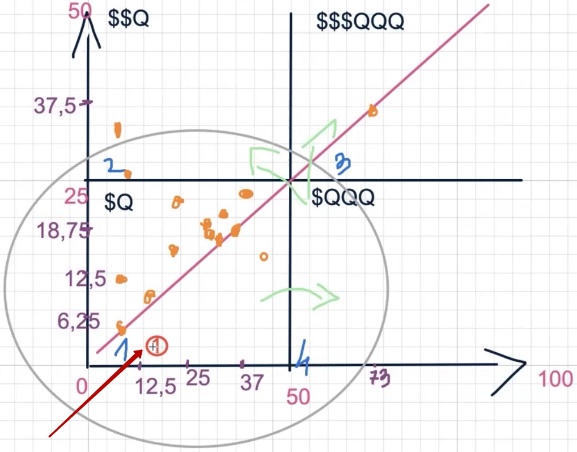
Consideration of the second segment ($1500-3500)
If we take the second price range, I have 1500-3500, and there are 90 sales here. That is a lot, and profitability is still in second place. That is, this “F” will be somewhere over here. The “F” will be drawn on the graph right here. I just put it here schematically. Just schematically in what context? I have it right here. I’ll probably take a picture of this whole story for you, and then I’ll put it somewhere, or a picture, or something like this. If you don’t see it, I’ll ask the editor to take a photo and put it on.
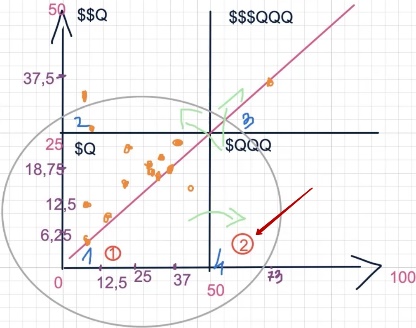
The third segment ($3500-7000)
I made the same quadrants. The same ones, I put the same scale there: 20, 41, 52, 77, 90, 100. I also made a vertical profitability. My maximum was 2363, and the minimum was 49. And I got a one at the bottom. This is a “D”. I got a “C” somewhere around here. Here are the three in the price range. Somewhere in the middle, it turned out to be neither here nor there. A “C” is how many sales we have? 52. The profitability here is average compared to others.

The fourth price range ($7000-15000)
The fourth price range again fell right here. The fourth one is somewhere around here. I also draw schematically. Then I’ll post a picture of what I drew somewhere here. Let you have it.

Fifth segment (more than/equal to $15,000)
And we have the fifth segment left. It will be the fifth if we look at this plate. There are 41 sales here. If it is a lot and highly profitable, it will be somewhere over here. But there are not many sales. So I got an “A” somewhere around here, roughly.
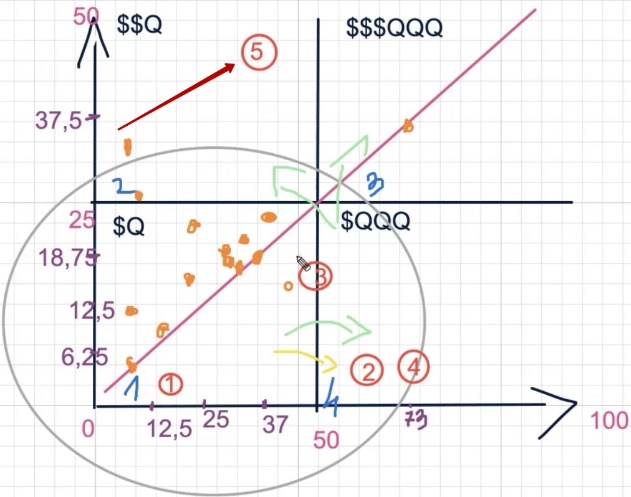
Moving from the first quadrant to the neighboring ones – up or to the right
Why am I showing you all this? If we take as a basis some more or less… These are, in short, resources that can be used to move to this quadrant, which we discussed, to move here, where we can at least stay on some kind of framework. And what can allow you to quickly move to this segment. The one-unit remains here, and there is practically nothing left. As I said, the relatively low price range always spins in the first quadrant. You can try to move it to the fourth quadrant, so that it becomes a pulling force. But it all depends on whether you need it or not.
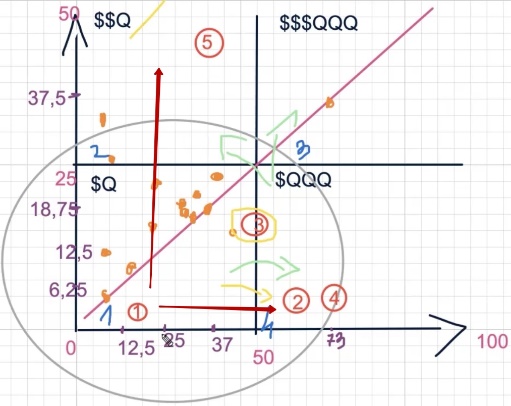
In this case, we can try to do it, because 49. So we think it’s low relative to other indicators in this account, but it’s not low in terms of some average values in Ukraine, for example. Right? That is, if we…
What is the point of this video?
The essence of this video is that using a real account as an example, based on a simple schematic analysis, you can determine exactly how effectively or ineffectively the strategy works, the maximum conversions or profitability in this particular case. What can be accentuated as categories, or what can be used to do this.
I mentioned this in terms of the average check, but most likely even typing can play a role here. Because here, campaigns are still partially broken down by type, not by check. It’s not bad enough to split by these types, it’s great for audience targeting. But most likely, these types will have to be cut into something else, split into pieces in order to try to drag at least one segment somewhere, into one of the quadrants. This idea of breaking it down into these quadrants came to me… How to say it, but how to describe it. It is not like a kind of mechanics of demonstrating how the maximum conversion rate and target profitability work in relation to this graph.
How do strategies work when starting with small budgets?
It could be represented as follows: when we start with small budgets for maximum conversions, according to these quadrants, we can have approximately this much, the maximum conversion. The lower the price per conversion we want to set. Why a lower cost per conversion? Because we want to pay less and earn more. That’s why the income is higher here. And if we want to increase conversions, we need to increase this price per conversion. That is, to increase the cost part in order to move into this quadrant. As you can see, it will be very difficult to climb into this quadrant with the help of maximum conversions, very difficult. I’m not saying that it’s going to follow this trajectory exactly. It can go from here, a little bit lower, a little bit higher.
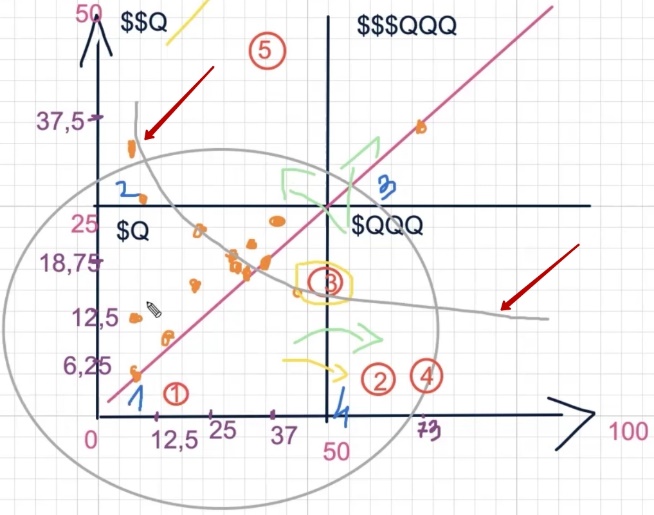
But profitability goes a little bit the other way around. It usually follows an upward arc, the opposite of how CPA works. Let’s say it’s a CPA. I’m going to sign it now with a CPA. And let this be ROAS. I’ll draw an ugly percentage. So, let’s see. So, here, when we set the profitability to high, we set the profitability to high, we want to cut a certain number of constraints.
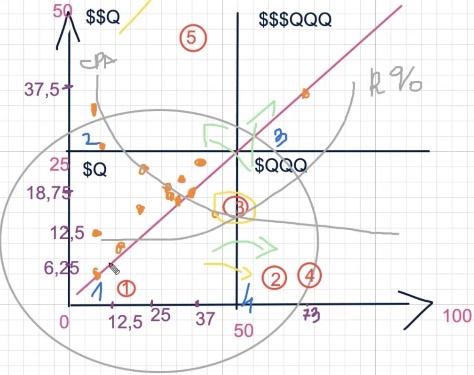
We will have less revenue in proportion to the number of units. As soon as we start to reduce our profitability… A decrease in profitability is the same as if we were to increase the cost side. That is, a decrease in profitability is an increase in expenses. Let’s say a decrease in ROAS is like this. ROAS leads to an increase in costs like this. An increase in CPA leads to an increase in dice as well.
If we want to get into this quadrant and even touch this quadrant… You see, everything is logical. If we want to move up in profitability, then we are going upwards. But, in part, we can also climb into this segment, the quadrant where some categories will have to be taught to generate the right profitability first, and then move up a few units. This is a variation – first here, you can climb here, but it depends on the initial data with which we start. If our profitability is already on the verge of adequacy, it will most likely be very difficult to jump right through this profitability arc and we need to first climb into this second quadrant in order to somehow turn it into a more profitable thing.
The influence of the average check size on the achievement of results
But what do average checks have to do with it? Why do they matter? Because your average checks – the emphasis on one or the other – will be determined as easier, which will help you achieve certain results. Why? Because, for example, we have a product… It’s not in this account. Well, let’s say it’s 700 hryvnias, conditionally. It’s 660, something like that. This is the minimum starting position that is available in the account. It sits in some campaign that is not in the top even in terms of conversions. We can take, for example, a product for 2000 UAH. Or let’s have it directly on this account.
Here we have a campaign that has generated the most conversions. We go into this campaign. We are going into products. My goods will all be covered with vomit. You won’t see much of anything. What do I want to demonstrate? You can estimate for yourself which of the checks makes the most conversions. I think this is our second segment. Let’s see it here. This is a top advertising campaign. Let’s see, I’m filtering here by conversions. Let’s say it’s more than one conversion. Let’s take the conversion column. Let’s take Conversion greater than one. I don’t want to take zeros, there are 0 and something. But we can accept that you saw the scale of the situation. Look here. You see 0.10, 0.20. Let them be more than zero conversions.

What do we see here? Three, maybe one and a half. And here’s a check for six. Two, three. You have to sit down and add it up. At first glance, it looks like it’s up to 3.5. Let’s take 45 positions here, all of them made some kind of conversion. Although, in fact, they did not make these conversions, there are many halves here. But we can calculate this using this attribution model.
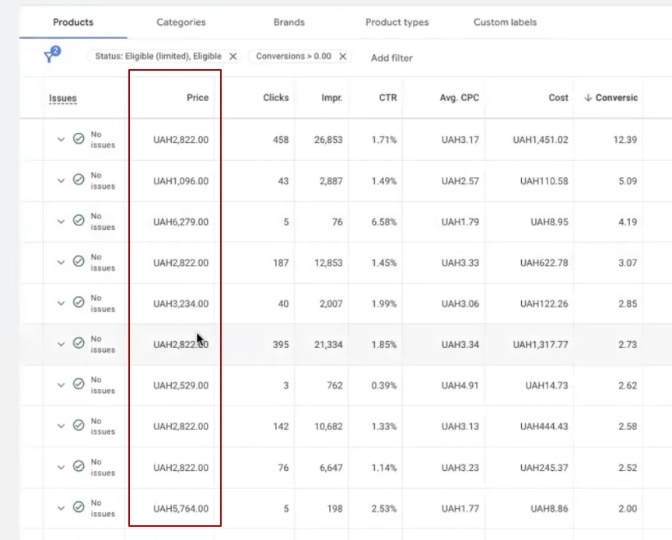
What can we do? We can add the same price list. And, for example, more, here I have what? Remember 1500 UAH in this campaign. How many conversions did I have? Just five plus two – 7, 8, 9, 10. Let’s say there are 10 conversions in total. Right? Then I take more than 1.5 thousand and charge a price less/equal to, let’s say, 3500. Right? What do we have here? 12, 15. Let’s say 3, 18. Plus 18. And here’s a decent amount of numbers. You can see 32 and the number of conversions right here.
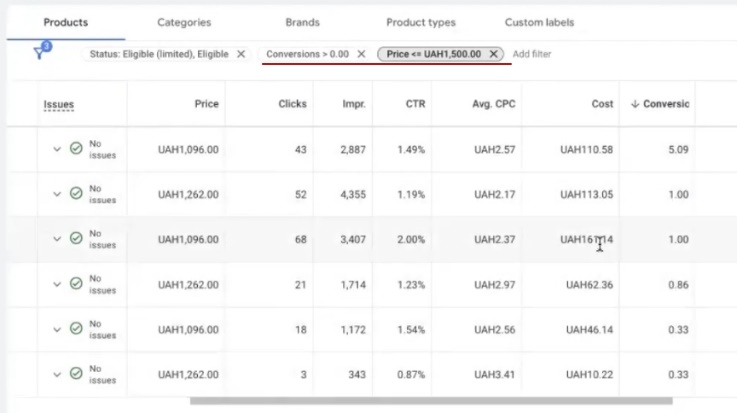
This average price range is most likely to generate the bulk of my revenue in this campaign. Because if I choose more, for example, just 3,500, then, most likely, you see, I have no conversions at all. That is, this average price range is my main exhaust. This is the average price range. And we have a numbered middle price range, and 3500 is just a two. Here it is, you see, here’s a “D”.

That is, the top advertising campaign, which makes both profitability and money, does it more due to the second price range. This is how you can find out what can act as a generator of a particular story, because in some accounts, a certain price range can be a money gobbler. It can simply eat money, give low profitability, and not give this result.
The same scheme can be done in the context of price and type of product. Because depending on the type of product, who you want to sell it to, it means a lot. And this quadrant is also subject to the same principles of product typing, which type of product is in which quadrant, so you can cross over, go to the fourth quadrant. Perhaps, if they are there under the question of profitability, you can first move to the second quadrant, or you can immediately move to the third quadrant.
What is the best way to switch to profitability and what kind of profitability should you set?
In general, why did you decide to make this video, to show an example? Because people have a question – how best to switch to profitability. What size of this profitability should be set in this case. And I said that I don’t recommend overestimating the profitability of the fact that you see. If we have a profitability in this campaign, let’s say it’s 20 percent or whatever, or whatever it is here – 36 percent.

It would make absolutely no sense to set the same profitability or make it much higher. Because this is a weighted average number that we just see in fact. And this 36, what are we doing? There is only one point in switching to profitability, because only with profitability can we cover more quadrants, more widely and most likely with greater profitability.
But if we just switch to profitability out of the blue and set the same 36, here’s 36, we will stay right here. Because we have not preserved this principle. In order to migrate here, we need to underestimate our profitability. That means we will stay here.
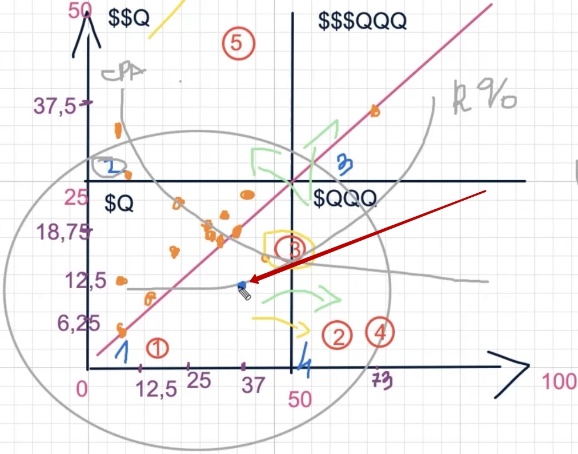
Not only that, but when we set actual profitability, we are likely to go down even further in terms of units. We’re slipping somewhere, even here. I don’t know, maybe you have some miracles happening in your advertising accounts. I don’t know. I do this on a sample of a large number of accounts, give or take, where you do the same set of actions, test it, and it leads to such and such results.
I don’t actually recommend setting it up, but there are guys who recommend it after maximum conversions… This campaign worked for maximum conversions. In general, you just take a figure and then add some percentage on top of it. In general, in order to do this proportionally, you need to raise the advertising budget many times over, just to maintain at least some kind of ratio, all these stories. The advertising campaign will then take longer than usual to adapt, to calculate how to achieve this. And this will most likely set you back a few steps.
Will they be critical? No, they won’t. Most likely, with this format, if you’re setting up, you’ll try to roll it in right away. From here, from this point, you will want to immediately duck here, which is a good option. But remember about the quantity. And the income here may simply not be proportionally beneficial to you, even in the first periods. Because these things, they usually fall many times, if we want to present this fact.
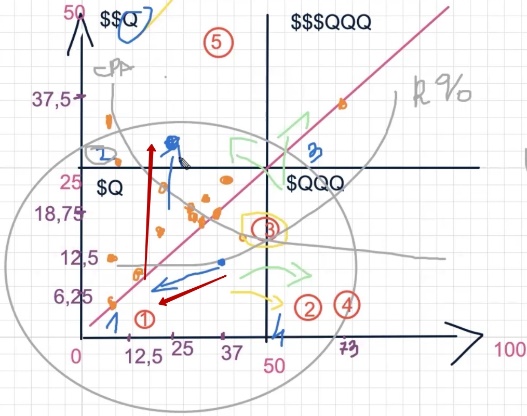
So we need to go a little bit along this line of profitability in a different context. How much of a direct percentage is it to edit in this case? Well, hell, I’ll tell you all the secrets of the firm. Watching the video, everyone will start using abstruse phrases, like after a consultation with specialists. Then clients come to me and say things in my own words, but from other specialists. And it’s a little bit distorted, wrong. Therefore, it is not entirely appropriate for me to say how it will move, but the principles remain the same. That is, if you set such a profitability.
That’s why Googlers, for example, write that after the transition, they write on foreign resources like they do. Many clients complain that after they set up and switch to the ROAS targeting strategy, their ROAS drops dramatically. Of course, this is because people don’t know how to set ROAS according to your manual. Google doesn’t write a manual on how to set profitability. It only writes a manual – define such a large budget and give it, in some manuals it says, give it four weeks. In some he says a week, in some twelve, in some six weeks. All the manuals always have a different time limit. Let her learn. You just give them money and let them learn. It’s a very cool option for those projects that have immediately allocated a test budget for this whole story, and they are ready to invest in it. It will be very cool if the result is 50×50. There were situations when clients came and lost 10,000 dollars. Some had much less.
Well, it doesn’t happen once in a while. This is before this whole story. So it makes no sense to set it so high. Especially at such high margins, if they are real. 36 is 3666. Oh, that’s 36 thousand. Right? 1,000 if I multiply it. How much is that? 36,000%, right? I mean, 36,000% is a lot. Oh, or 3600%. God, I’m already confused. Please correct me then. This is a very high score. Some people just strive for the top ten and think: “Wow! It’s cool.” Why are the numbers so high here? There are many factors that influence this, but one of them is the maximum conversion rate, which always works better than profitability. That’s why you shouldn’t immediately assign a fact.
How to conduct a profitability test?
What is the best way to conduct a test? It’s better to run a test with a transition to profitability on some assortment that can be done most easily. But since we have a 73-piece ad campaign, it converted 73 pieces. Its profitability is great. Yes, it’s in this quadrant. It’s right there. But if you look at the distribution of impressions, most of the products are simply not working. If we just filter by impressions. We have only 2000 items here. 2000. Is that right? And the main emphasis is on literally 10,000 impressions. Here are 2, 3, 4, 5, 6. There are 6 to 10 product items. See? Up to 10 product items receive a significant number of impressions relative to other products. All the rest, I don’t know…
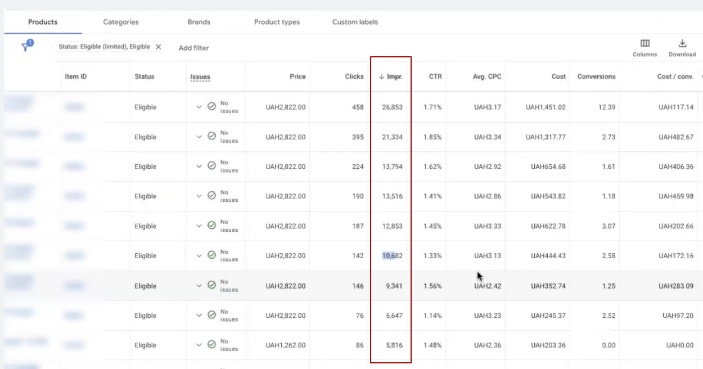
Well, just take 483 impressions and divide by 30 days. Do you get a lot of sales? Very unlikely, then most likely your tests will be most painless for your ad accounts to do on these products that have not been shown at all, very little shown. That’s the concept. Take, analyze by type, by these quadrants, which type of product you have in which quadrant, combine the type of product in the context of the price range, because profitability is always still correlated in its rates to the average check that you will use. It also takes part in the calculation of this whole story.
That’s why profitability is always overestimated on more budgetary products. And on more expensive products, it is set a little lower on purpose, so that they have a priority exit and because you can spend more on a high check. There is a gap in these prices for conversions. And test this strategy there, this option, rather than when you just switch the switch in one campaign to another.
The difference in the strategies of target profitability and maximum conversions
Of course, the target profitability strategy is fundamentally different from the maximum conversions. This is the maximum conversion rate, and your profitability can be in all quadrants. The likelihood that these profitability landing points will be profitable for you depends only on these statistics, analytics, what was sold the most, what segment. And it’s not just how I analyzed it. The AI calculates this other graph and compares them. It sees even more information hundreds of times more. Perhaps, if we were to describe all this, everything would be in cripplingly small terms, there would not even be any white space, no room.
You need to try to do it, just to switch the switch in this campaign to profitability. It’s possible, but you probably won’t like it, considering that even the maximum conversion rate in these ratios of 280 UAH and 519 UAH is also a little bit wrong.
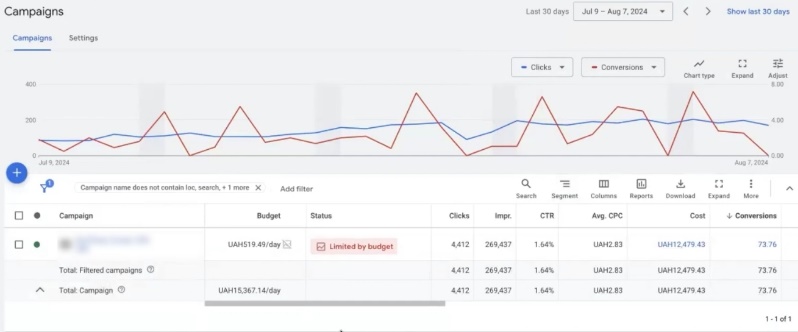
Because the maximum conversion rate, it requires a certain ratio of the budget to the price per conversion. If you want to increase the conversion right here, you just need to try to skip the budget. Because you missed the conversion because you raised the CPA, but you didn’t increase the cost part. There are also peculiarities in this whole story. Maximum conversions – it is very sensitive to this. With a budget of $8-10, as most people recommend, it can start generating very low-cost conversions in a certain price range. If we just climb into some price range that does not include this one, the proportion immediately goes up, the budget is multiplied by an average of 2-2.5, and the price per conversion is not $10 or less, but 10 multiplied by 2, or even 2.5. That’s why you wonder what the maximum conversion rate is doing to you. And why it is so bad, and why the profitability was better. Some people argue that the maximum conversion rate was okay, but the profitability was not very good. You have to sit and dig into your account and see it all.
Tips for this advertiser
What do I recommend to this advertiser? You need to analyze these quadrants beyond the analysis I’ve done. You know your campaigns better than I do, how you set them up. The sequence of all these things that you’ve done, you also understand it all, you know it all. You know what product mix is sitting there, what is better, what is worse. If you do this, you should at least make another quadrant like this and analyze it separately by type and overlay it with types in the context of prices. Because I don’t have a lot of time to just sit and analyze these accounts and display all these tables in order to visually demonstrate to you that when you have your eyes full, you immediately see it in a different format. And in your head, you can visualize it all. I mean, that’s how I see it in my head. And when you put additional operations on top of that, of course, it takes time. You can do the same thing. See what you can scale with, in what aspect, with what combinations of either profitability or cost per conversion. See if something works better for you or not.
Basically, there are advertising campaigns here that are based on profitability. I don’t remember if I looked at them or if they worked. Let’s look at this maximize conversion value, for example.

Here, the conversion rate is 33 or 30 days, did you change the Bidding strategy here or not? It seems not. Only the budget. That is, it has been working on these strategies for at least a certain period of time. It seems that the budget was simply increased. Right? It’s just that her budget has increased. Try to see how she works, what she emphasizes. More or less. You can see right away that the bones are much higher. Right? The cost per conversion is much higher, but at the same time, the profitability doesn’t suffer super significantly.
Now, let’s see, if we see all these conversions, what is the average check that is played here? Even with the naked eye, you can see right away that a check of 3500 or even up to 7 and a half is in the mix. But here, 3, 2, 5, 6, 7, 8, 9, 10, a check is already being cashed, which is much more expensive. It includes a more expensive segment. That’s why this strategy probably works quite well on this budget and yields such high profitability.
I don’t remember what the size is here. Here, this campaign works without any limit on profitability at all. And why does it yield such high returns? There are several reasons for this. First of all, the account already has analytics and statistics on high profitability, so you can easily move from the maximum conversion to another type of conversion. And the budget, which is in the context of the price range, remember, we said that your price is also involved in all these ratios. It affects what… How many goods are there? And there are 5000 products here. This generally affects this picture of the distribution of conversion impressions. You see, it proportionally affects the performance.
This is not a plus for this campaign. It is rather a disadvantage. Because if you see, yes, the profitability can be great, wonderful, but it is not solved by effective targeting of the advertising campaign, but by the fact that the check is higher than just the cost part. You see here it shows 809 conversions, but 0.65. I’m not sure if this is a full conversion. Right? Maybe this 1.65 is actually drawn on some 1.80 plus 1.80, for example. Oh, 0.80 and something like 0.80, so the total is 1.65. Maybe there was one sale here, but it’s not 809 UAH, and 1336 conversions can be taken, for example, 1336 UAH. And if we divide 13 thousand, let’s say 13,000, by 1336, we’ll get a profitability of 9.7, not 13.99.
By the way, this is a problem with the data-driven attribution model, because I’ve calculated the difference between one conversion and another, even with the same halves, and it’s quite significant. Yes, well, it’s quite significant in terms of things. In this case, I deducted 13 conversions, because one item with two clicks made 13 conversions. It’s unlikely that these 13 conversions exist at all, or that this person ordered 13 times. It’s not specific, it’s not standard, so we can’t say that it’s a statistical value. That’s analytics for you.
Analysis of the changes made by the client in campaigns
You should try to see it all and determine how you will continue to grow. The strategy is great. Here is the profitability, it can handle it. If they try to go to the maximum conversion rate, you can probably reduce the price per conversion, but they will definitely ask for more money. In order to determine what kind of profitability you need to set, you need to analyze the average values of all these profitability, try to lower it a little. I’m not going to say how much I’m going to underestimate it in terms of percentage. In this case, it would still not be appropriate enough. You need to play with these values. I’ve seen campaigns here with even 1000% ROI, I think. Here’s 1300, for example.
Let’s see, it’s 1300, and let’s scroll somewhere. But it’s not very active. They are trying to increase traffic on it. By the way, let’s take a look at it. Maybe there was something called Bidding Strategy on it. No, there is no bidding here. In general, they tried to increase the budget to 168. Here it is 140. The problem here is the small budget. It’s a very small budget for such high profitability. It’s not going to go out of business like that. Thanks to Google, it is massively raising these indicators of high values. You will raise the budget here. They will become a little bit more positive. I don’t see any badding here, definitely.
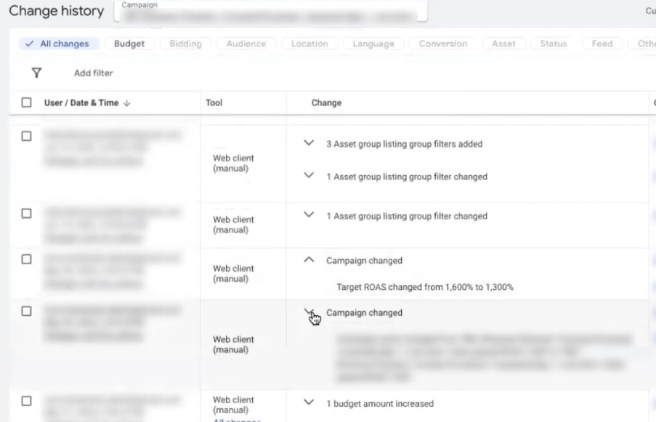
We may have had 1300%, but the ROAS is very low. Let’s say May 30. Yes, May 30. What do we have here? ROAS went down a little bit, July 10. What did we have? July 10. There are some filters here. If something was excluded, it means that there will be a little more budget for the remaining part. 1300, and that’s probably the most likely reason why someone was excluded. There was a little bit of budget left over, and I had to convert it for the rest. July 18 – this budget was reduced to 77 UAH. Well, this approach works for maximum conversions, it works for profitability. You won’t succeed with such low budgets. You want to get a return on investment of 1000, but you can’t even provide clicks for your advertising campaigns.
Yes, it seems to look super attractive everywhere, but your problem is that you don’t give it a chance to grow. You have to try, but the budget is also important here. And the budget also plays a role. Because if you dig into the settings, you’ll find a thing called the budget allocation method. It’s uniform. But you can’t achieve very good performance and results on a uniform salary of 170 UAH per day. So what else do we have here? Our average cost per click is 3 UAH. Yeah.
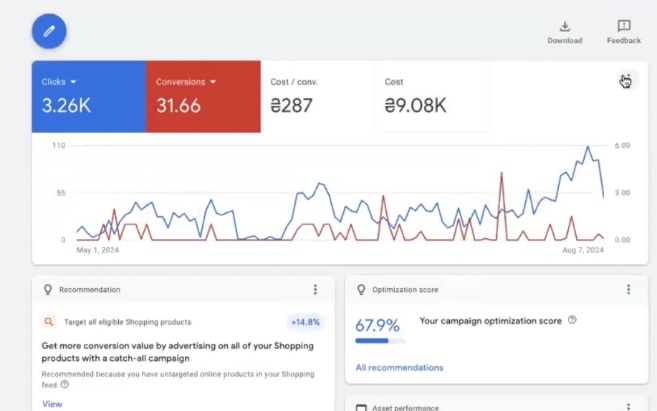
Why don’t you give me the option to add more metrics? This is Google. I don’t need any bones here. The traffic is gone. Here, the budget was allocated to CPC. Let’s have CPC. CPC has not changed here. It even fell a little bit here. This is a signal that this traffic may not be going exactly where it should. There are just not enough of these sales, so it looks more attractive, but the cost per conversion here is 286, but we have seen much higher for products. It doesn’t change the essence of the matter anyway. A slightly different principle worked here.
Conclusions on the project analysis
My conclusions from this analysis are as follows. Test on some products that are not an active part of any performance. Do it on someone who is already barely breathing in your ad account. You will test, try to migrate. Profitability requires a bigger budget. There are more dice. An increase in CPA rates also implies an increase in dice.
But CPAs think a little differently about all these costs. It can stop at a certain level. But you don’t need to if you have advertising campaigns that are doing below CPA. If you think that you can grow by simply increasing this CPA, but not changing these dice, then this is a false statement. You need to increase the dice proportionally if you increase CPA. Because this is a ridiculous story, if you increase the CPA size, you are not telling the system to spend more. Because if you want to move along this straight line, you need to enter new auctions.
New auctions mean new impreshens. And new impreshenes are always associated with an increase in dice. The question is, how will you ensure the increase in dice? How will you increase them? By excluding some products, as you did with the filters and starting to show some assortments. Or you will increase it by simply increasing the daily budget. Will you do this by reducing profitability or by proportionally increasing CPA, building up the bones. This is another question.
Try it, test it. There are no ideal values that would be used only for Ukraine. They just don’t exist. You need to customize your account to find the perfect one. Each account is individual, no matter how it may sound. Just like people. An individual account is individual because AI learns from your analytics. It makes its own charts, distributions, models, and other unique ones. That’s what Google says, that’s what’s cool about performances. Because they use artificial intelligence and can ensure that each advertiser gets the results they want.

